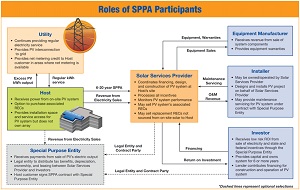Understanding power purchase agreements
 Power-purchase agreements are contracts, under which property owners (hosts) lease power-generating systems, financed by a third party, and use electricity generated by systems onsite.
Power-purchase agreements are contracts, under which property owners (hosts) lease power-generating systems, financed by a third party, and use electricity generated by systems onsite.
PPAs are a powerful tool in the solar developer’s arsenal, a financier helps reduce the up-front costs of installing solar on a home or building. In exchange, the property owner—host—enters into a legal contract—essentially an equipment lease—with the installer or a third party (usually an investment firm, a bank, or a community) and pays a set monthly rate for the duration of the contract.
Depending on the agreement, the host leases the system from the system financier for a period of anywhere from five years to 25 years.
The advantage of the PPA is that it allows the property owner a chance to get renewable energy without paying the up-front costs associated with a PV or wind system. It offers the hosting building owner a fixed price for energy produced by the system, which is generally offered at a less expensive rate than the building owner would pay for the same amount of electricity or a rate slightly higher than current electric prices, but lower than projected future prices. Under PPAs the developer or installer generally is responsible for maintaining the system. PPAs often contain provisions allowing system hosts to buy the system outright or transfer the contract to a subsequent buyer. At the end of the contract, the host may own the system outright, agree to a contract extension, or in some instances, the financier may take the system back.
Large-scale PPAs include agreements with the utility to purchase their excess electric generation, and in the case of a utility-scale development—say over 1 megawatt—the developer sings a contract with the utility under which the utility buys all power from the site over the period of the contract. For smaller developments, like a home-sized 3 kilowatt system PPAs allow the building owner an opportunity to net meter and sell additional generation (net excess generation) back to the grid. Homeowners are reimbursed at a pre-determined rate, usually set by the state, and are either allowed to carry net excess generation forward into other months to offset grid-supplied electric costs. But in some states, homeowners are reimbursed for their excess generation. System hosts under PPAs also are usually eligible for performance-based incentives for clean energy generation.
Incentives related to purchasing and building the system and tax breaks usually go to the developer or financier. This allows them to offer the host a better deal. And when a PPA is used to help a school or public institution install a renewable energy system, the PPA allows the financier to get certain solar incentives and tax breaks that the institution would be ineligible for on its own.
As PV penetration continues to expand across the company and across the world, expect to hear more about PPAs.



